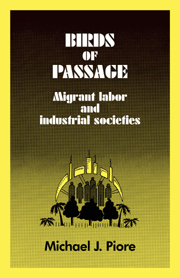Book contents
- Frontmatter
- Contents
- Preface
- 1 Introduction
- 2 The jobs
- 3 The migrants
- 4 Particular characteristics of the migrant labor market
- 5 The impact of migration on the place of origin
- 6 The historical evolution of long-distance migration in the United States
- 7 The dilemmas of current U.S. immigration policy
- Notes
- Bibliography
- Index
- Frontmatter
- Contents
- Preface
- 1 Introduction
- 2 The jobs
- 3 The migrants
- 4 Particular characteristics of the migrant labor market
- 5 The impact of migration on the place of origin
- 6 The historical evolution of long-distance migration in the United States
- 7 The dilemmas of current U.S. immigration policy
- Notes
- Bibliography
- Index
Summary
In the last twenty years most industrialized Western countries have experienced extremely heavy in-migration of foreign workers. By 1975 foreign workers had come to constitute 10 percent of the labor force in Western Europe as a whole. They represented 11 percent of the labor force in France and 9 percent in West Germany. In some countries the proportion of foreign workers is even higher. In Switzerland it surpasses 25 percent. Since the middle 1960s the United States has also been experiencing a considerable influx of foreign workers: The bulk of our migrant labor force is clandestine and its exact size is consequently unknown. Estimates run from two to twelve million.
In their origins these migrations often went unnoticed. Where they were officially recognized, as in Germany and Northern Europe, they were generally thought to benefit both the sending and the receiving nations. Both countries thought of the migrants as temporary. In the sending country the migration was supposed to relieve population pressure and overcome rural unemployment, to generate scarce foreign exchange, and to develop the skills requisite for an industrial labor force. In the receiving country, migrants were supposed to complement native labor, taking jobs that the latter did not want and in this way overcome critical labor shortages. Over time, however, the migration process has been the source of an increasing number of problems and a focal point of clashes between native and foreign populations.
- Type
- Chapter
- Information
- Birds of PassageMigrant Labor and Industrial Societies, pp. 1 - 14Publisher: Cambridge University PressPrint publication year: 1979



